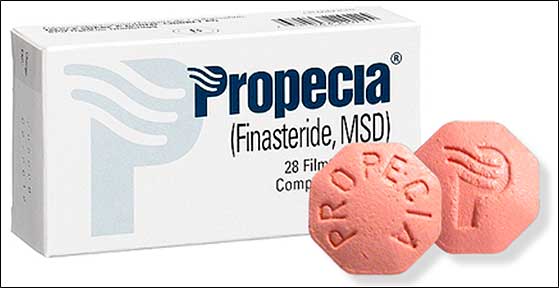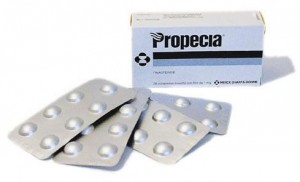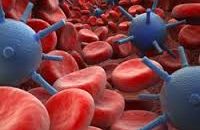Propecia (Finasteride): General Information
Finasteride (brand name Propecia), is a synthetic drug for benign prostatic hyperplasia (BPH) treatment and male baldness. The drug is 5alpha-reductase type II inhibitor. 5alpha-reductase is enzyme responsible for testosterone conversion to dihydrotestosterone (DHT).
| Pharmacological group: | a drug for benign prostatic hyperplasia treatment |
| Pharmacological action: | a drug for benign prostatic hyperplasia (BPH) treatment. Competitive and specific 5-alpha-reductase type II inhibitor – an intracellular enzyme that converts testosterone into more active androgen – dihydrotestosterone (DHT). |
| Systematic (IUPAC) name: | N-(1,1-dimethylethyl)-3-oxo-(5alpha, 17beta)-4-aza-androst-1-en-17-carboxylic acid |
| Legal status: | available only on prescription (UK, USA) |
| Application: | oral |
| Bioavailability: | 63% |
| Metabolism: | liver |
| Half-life: | elderly – 8 hours, adults – 6 hours |
| Clearance: | fecal (57%) in urine (39%) as metabolites |
| Formula: | C23H36N2O2 |
| Mol. weight: | 372,549 g/mol |
Application
Benign prostatic hyperplasia
In medical practice, Finasteride is used to treat benign prostatic hyperplasia (BPH), popularly known as «prostate enlargement». Dosage approved by FDA is 5 mg once a day. To achieve therapeutic results six or more months of the treatment may be required. In case of drug withdrawal, the disease can begin to develop again within 6 – 8 months. It reduces manifestation of symptoms associated with BPH, such as difficulties with urination, nocturnal urinary urgencies, delay at the beginning of urination and weakening of urine flow.
Action
 Synthetic 4-azasteroid compound, competitive steroid 5alpha-reductase type II inhibitor. This intracellular enzyme converts testosterone to active 5alpha-dihydrotestosterone (DHT). Inhibition of DHT production reduces prostate gland size. Finasteride has no affinity to the androgen receptor, whereby during reception testosterone-dependent symptoms in the form of increased weight and hirsutism do not appear. As a result of the use, DHT concentration in serum and urine, present in prostate, decreases, thereby reducing prostate gland size, increasing maximal volume flow rate of urine, the risk of acute urinary retention and risk of surgery necessity. Reducing DHT concentration in scalp prevents hair follicles miniaturization, suspending baldness process. After oral administration, bioavailability is approximately 80%, food intake does not affect absorption. Finasteride approximately by 93% binds to plasma proteins, penetrates the blood-brain barrier. Metabolism occurs in liver under cytochrome P-450 CYP3A4 isoenzyme influence. About 60% of the drug is excreted with feces, approximately 40% – with urine. T ½ is 5 – 6 hours, at patients older than 70 years – 8 hours. The effect, consisting of DHT concentration reduction, is maintained for 24 hours.
Synthetic 4-azasteroid compound, competitive steroid 5alpha-reductase type II inhibitor. This intracellular enzyme converts testosterone to active 5alpha-dihydrotestosterone (DHT). Inhibition of DHT production reduces prostate gland size. Finasteride has no affinity to the androgen receptor, whereby during reception testosterone-dependent symptoms in the form of increased weight and hirsutism do not appear. As a result of the use, DHT concentration in serum and urine, present in prostate, decreases, thereby reducing prostate gland size, increasing maximal volume flow rate of urine, the risk of acute urinary retention and risk of surgery necessity. Reducing DHT concentration in scalp prevents hair follicles miniaturization, suspending baldness process. After oral administration, bioavailability is approximately 80%, food intake does not affect absorption. Finasteride approximately by 93% binds to plasma proteins, penetrates the blood-brain barrier. Metabolism occurs in liver under cytochrome P-450 CYP3A4 isoenzyme influence. About 60% of the drug is excreted with feces, approximately 40% – with urine. T ½ is 5 – 6 hours, at patients older than 70 years – 8 hours. The effect, consisting of DHT concentration reduction, is maintained for 24 hours.
Indications for Use
It is used exclusively by men to control course and treatment of benign prostatic hyperplasia in order to reduce enlarged prostate gland, increasing urine maximal flow speed and reducing symptoms associated with hyperplasia, the risk of acute urinary retention and associated with the risk of surgery (including transurethral prostate gland resection and prostatectomy). Also used for male baldness treatment.
Contraindications
- hypersensitivity to any drug component;
- not allowed to be used by women and children (in conjunction with the ability to inhibit testosterone conversion into dihydrotestosterone, medication, taken by women during pregnancy, can cause malformations of male fetus external genitalia);
- patients with large residual urine volume should be carefully monitored for uropathy development caused by urinary tract obstruction.
Drug Interactions
There are no clinically significant interactions with other drugs.
Pregnancy and Lactation Period
«X» category. Not used at women. Pregnant women or women of childbearing age should avoid contact with crushed or broken pills containing this substance.
Dosage and Administration
Benign prostatic hyperplasia: 5 mg 1 time a day, regardless of meals. In order to evaluate Finasteride treatment effect, it must be taken for at least 6 months. Acute urinary retention risk reduction occurs within 4 months of treatment. There is no need to change dosage in case of renal insufficiency or in elderly patients.
Male baldness: 1 mg 1 time a day; treatment duration should be not less than 3 months.
Finasteride for Boldness
During 5-year-lasting study of men with mild and moderate alopecia, during hair counting it turned out that at 2 out of 3 men taking 1 mg daily hair growth renewed. In contrast, all men in the study who did not receive finasteride showed hair loss.
In the same study, based on photos, reviewed by independent dermatologists group, it was determined that 48% of patients treated with this substance, observed visible hair growth. Another 42% did not experience further hair loss.
The average number of hair in the treatment group was higher than original mark and differences in a number of hair between Finasteride and placebo groups, during all five years of research, have steadily been increasing. The first mentioned drug is only effective during therapy. Clinical studies have shown that minoxidil and Finasteride influence both parietal region and hairline, but more effective – parietal region.
Recent 10-year study of 118 men suffering from androgenetic alopecia, taking 1 mg a day, showed that 86% of men who continued treatment throughout 10 years, observed increased or preserved hair growth rate and only 14% of patients reported further hair loss. It has been found that patients who have demonstrated greatest hair growth during the 1 year of treatment, have more pronounced hair growth after 5 years of treatment, almost at 69% of such patients hair growth continues. However, many patients who didn’t experience hair growth during the 1 year of treatment showed further improvement. It was also found that in patients over 30 years hair growth generally increases in long-term perspective.
Side effects were observed only in 5,9% of patients, none of them reported symptoms such as depression or gynecomastia. Authors concluded that this drug effectiveness in androgenetic alopecia treatment is not reduced over time even in older patients (including patients over 40 years). In general, the drug is well tolerated. In the study, patients, who continued using the drug, were considered separately. The recent case-control study, in which men, who suffer from hair loss and after stopping taking Finasteride experienced mental complications, participated, reported the presence of depressive symptoms and suicidal thoughts at patients that when using drug also experienced sexual side effects.
Some users in an attempt to save money, instead of Propecia buy Proscara (Finasteride 5 mg) and divide a Proscara pill into several parts, bringing thus its dosage to Propecia dosage. To prevent contact with active ingredient when applied, pills are coated with the special layer. Dust or crumbs from broken Proscara pills should be kept away from pregnant women or women who may become pregnant.
 Use for Other than as Intended
Use for Other than as Intended
Because of anti-androgenic properties, Finasteride is sometimes used in hormone replacement therapy in transsexual men combined with estrogen form. Nevertheless, there are too few clinical data of its efficacy in this regard is limited. Indeed, Finasteride, compared with conventional anti-androgens such as spironolactone and cyproterone acetate, is much weaker material. Moreover, its use is associated with high risk of anxiety and depression in both men and women; transsexuals are in a particularly high-risk group because these symptoms are very common among this group of patients. Therefore it is not recommended to appoint it as anti-androgen for transsexual men because the drug increases the risk of harmful emotional side effects. It was also found that it helps to facilitate withdrawal effects mitigation after chronic alcohol consumption.
Side Effects
- impotence (1,1 – 18,5%);
- excessive ejaculation (7,2%);
- decreased ejaculate volume (0,9 – 2,8%);
- sexual function disorders(2,5%);
- gynecomastia (2,2%);
- erectile dysfunction (1,3%);
- ejaculation disorders (1,2%);
- pain in testicles.
In accordance with information included in product packaging, recovery was observed in men who discontinued treatment due to these side effects, and at most men who continued therapy. The manufacturer also says about reported persisting erectile dysfunction, despite drug discontinuation. In December 2010, «Merck» added depression to side effects list.
In November 1997, FDA refused to recommend approval of Propecia drug to treat male baldness. Although not disputing its effectiveness, Committee members expressed some concerns about the possibility of long-term side effects on sexual function and even on reproductive function, because of data on ejaculate level decrease.
Prostate Cancer
FDA added warning on the packaging that the drug may increase high-grade prostate cancer risk. Although there was not found Finasteride influence on prostate cancer development risk, evidence suggests that the drug is able to temporarily increase and decrease benign prostate tumors incidence, but also can mask early signs of prostate cancer. The main problem is patients whose prostate cancer when taking it develops to benign prostatic hyperplasia, which in kits turn can delay prostate cancer diagnosis and early treatment, thus potentially increasing grade prostate cancer risk at these patients.
Prostate cancer prevention test in 2005 found that at a dosage of 5 mg per day, usually prescribed at BPH (benign prostatic hyperplasia), participants, taking Finasteride, showed 25% decreased chances of prostate cancer development at the end of the study compared to placebo group. You can mistakenly think that it increases specificity and selectivity of prostate cancer detection, thereby creating the visible increase in tumor risk with high Gleason score indicators. 2008 update of this study has shown that Finasteride by 30% decreases prostate cancer risk. In the original study, the decrease in prostate size caused by Finasteride contributed to cancer and aggressive cells identification. Most men in the study, with low and high indicators of prostate cancer, decided to be treated, and many of them had surgery to remove the prostate. Then, pathologist carefully examined each of those 500 prostates and compared kinds of cancers detected in course of operation with biopsy diagnoses. This study showed that it does not increase the risk of high-grade prostate cancer development.
Sexual Side Effects
There were reports of a sustained reduction in libido or erectile dysfunction, even after drug discontinuation. In December 2008, Swedish Medical Products Agency conducted research about safety and concluded that its intake can lead to irreversible sexual dysfunction. To updated safety information, as possible drug side effect, the agency added the occurrence of difficulties with erection, remaining for an undetermined period, even after Finasteride withdrawal. Medicines and Healthcare Products Regulatory Agency UK (MHRA) reports data about erectile dysfunction that persists after this drug discontinuation. These labeling changes have been also made by the Italian government. The mismatch between European and North American warning signs about dangers of persistent sexual side effects while taking Propecia remained for some time. However, two years later, in April 2011, «Merck» revised US warning in consumer and medical leaflets and included persisting erectile dysfunction after Finasteride discontinuation. In April 2012, FDA decided to approve proposed in 2011 labeling by «Merck», after including a report about persistent libido, ejaculation and orgasm disorders in warning label.
Anxiety and Depression
It was found that Finasteride causes depression and anxiety in animals. Accordingly, its clinical use has been associated with depression and anxiety at both men and women, as demonstrated by several reports from medical literature. In one study, 1 mg a day caused moderate and severe depression in 19 out of 23 (83%) participants, including, all female patients. In addition, in some cases marked anxiety accompanied depressive symptoms development. Another study with larger sample amount out of 128 men (without women), who were taking 1 mg a day, showed that Finasteride increases depression rates on both BDI and HADS. Authors concluded that patients with high risk of depression should administer this drug with caution. In late 2010, «Merck» revised information about Propecia label in the United States and Canada, adding depression to list of possible drug side effects. In August 2012, a study including 61 former users with persistent sexual side effects, showed that 75% of them showed a significant increase in depressive symptoms compared with control group. Among men who were taking the drug, 36% experienced severe symptoms, 28% – moderate, and 11% – mild. Furthermore, 44% of men had suicidal thoughts. In control group of 29 men, 10% showed depressive symptoms, all of these cases were mild, and 3% reported the occurrence of suicidal thoughts. It was concluded that Finasteride can cause depression symptoms and suicidal thoughts in some people, which remain even after treatment cessation.
Breast Cancer in Men
In December 2009, Medicines and Healthcare Products Regulatory Agency the UK announced an update of recommendations on Finasteride safety and potential risk of breast cancer in men. The Agency concluded that although clinical trials while taking 5 mg observed a significant increase in overall incidence of breast cancer at men while using it the possibility of increased risk of breast cancer at men cannot be excluded. Warning about this risk will be included in product information. «Merck» revised warning in consumer and medical leaflets in the United States, have included the risk of breast cancer in men.
 Finasteride for Women
Finasteride for Women
FDA included Finasteride (learn more) in «X» drugs category during pregnancy. This means that the drug may cause congenital deficiency at the fetus. Pregnant women or women who may become pregnant should avoid any interaction with crushed or broken pills since the drug can be absorbed through the skin. It is known that it causes a congenital deficiency in developing male children. If possible, avoid whole pills exposure, although its effect is not harmful as long as the pill is swallowed. It is not known whether this component penetrates breast milk, so women should avoid using this drug. Finasteride can penetrate sperm, but «Merck» states that pregnant woman’s contact with the sperm of a man is not dangerous. Finasteride acts on donated blood and potential donors are usually suspended from donation at least one month after the last dose.
Bodybuilding
Many sports organizations have banned Finasteride because the drug can be used to mask steroids use. Since 2005, it is on the list of substances prohibited by World Anti-Doping Agency. However, in 2009, the drug has been removed from this list. A number of well-known athletes who were using Finasteride as a remedy for hair loss and excluded from international competitions headed skeleton racer Zach Lund, bobsledder Sebastien Gattuso, football player Romario and goalkeeper in ice hockey Jose Theodore.
Mechanism of Action
Testosterone in men is mostly produced either in testicles or in the adrenal gland. Most of the testosterone in the body is connected with sex hormone binding globulin (SHBG), the protein produced in the liver, which transports testosterone through the blood, prevents its metabolism and prolongs its half-life period. When released from connection with SHBG, free testosterone can enter cells throughout the body. In some tissues, especially in scalp, prostate and skin tissues, testosterone, under 5alpha-reductase enzyme influence, is converted to 5alpha-dihydrotestosterone (DHT).
DHT is a more potent androgen than testosterone (having approximately 3 – 10 times greater activity against androgen receptor – androgen hormones action area), therefore 5alpha-reductase may be considered to enhance testosterone androgen action in those tissues where it is located. Finasteride, 4-azasteroid and testosterone analog, act as potent and specific, the competitive inhibitor of one of the two 5alpha-reductase subtypes, in particular, type II isoenzyme. That is, it binds to the enzyme and prevents endogenous substrates metabolism such as testosterone. 5alpha-reductase type I and II are the cause of about one-third and two-thirds of DHT systemic production, respectively. Other substrates include 5alpha-reductase, progesterone, androstenedione, epitestosterone, cortisol, aldosterone and deoxycorticosterone.
Full physiological effect on their recovery is unknown, but it is probably related to their release or by itself is physiological. Apart from the fact that the drug acts as a catalyzer to testosterone recovery reaction speed limit, I and II isoform of 5alpha-reductase enzyme restore to progesterone to dihydroprogesterone (DHP) and deoxycorticosterone to dihydrodeoxicorticostenore (DGDOC). In vitro and animal models indicate that subsequent 3alpha DHT, DHP and DGDOC recovery leads to steroid metabolites creation that affects brain function by increasing GABA inhibition of gamma-aminobutyric acid. These neuroactive steroid derivatives increase GABA level on GABA (A) receptors and exert anticonvulsant, antidepressant and anxiolytic effects, as well as affect behavior associated with sex and alcohol. Intraocular fluid 5alpha-dihydrocortisone is synthesized in the lens and may be involved in the intraocular fluid production.
Allopregnanolone and DGDOC are neurosteroids, the latter may affect animals susceptibility to epilepsy. 5alpha-dihydrocortisone is a potent antidiuretic agent, although it is different from aldosterone. 5alpha-DHP is one of the main hormones in the blood of women with normal cycle and pregnant women. By inhibiting 5alpha-reductase Finasteride prevents testosterone formation to DHP using isoenzyme type II, resulting in DHP level in serum lowering by about 65 – 70%, and DHP level increase in the prostate by 85 – 90%, where type II isozyme expression dominates. Unlike double inhibitors of both 5alpha-reductase isozymes, which can reduce DHP levels in the whole body by more than 99%, Finasteride is not able to completely inhibit DHP production. It cannot have a significant inhibitory effect on 5alpha-reductase type I isozyme having a 100-fold lower affinity to I type compared to II.
In addition to blocking type II isoenzyme, Finasteride competitively inhibits 5beta-reductase type II isozyme, however, it is not believed that this influences androgens metabolism. By blocking DHP production, Finasteride reduces androgen activity in the scalp. In prostate glad 5alpha-reductase inhibition reduce prostate volume, reducing benign prostatic hyperplasia (BPH) development and prostate cancer risk. 5alpha-reductase inhibition also reduces epididymis weight, reduces mobility and changes normal sperm location in the epididymis.
Pharmaceutical Form
Trade names include Propecia and Proscara, which, firstly, are used to treat male baldness, and, secondly – for benign prostatic hyperplasia (BPH)treatment, and both are «Merck & Co» products. Propecia contains 1 mg of Finasteride and Proscara – 5 mg. «Merck’s» patent for Finasteride for BPH treatment has expired on June 19, 2006. «Merck» obtained a separate patent for use for male baldness treatment. This patent has expired in November 2013. Studies have shown that the dose necessary to treat male baldness is less than 1 mg. FDA received petitions for approved dosage reconsideration in light of statistics and possible long-term risks.
However, FDA announced that there was research result which showed that at the dosage of 1 mg compared to 0,2 mg enhancement effect without additional risks was demonstrated. The same study also concluded that dosage of 0,01 mg per day has been ineffective in baldness treatment. This drug is a lipophilic substance. Not so long ago liposomal system for local use began to be developed. Formulas for local use may have some effect on androgenic effects on hair follicles, as well as hirsutism. Later studies examined Finasteride microemulsions and liquid crystal nanoparticles for local use. In the latter case, the addition of glycerin, propylene glycol, polyethylene glycol 400 increased Finasteride penetration, while the addition of oleic acid caused penetration reduction. Finasteride for local use in combination with minoxidil is more effective than minoxidil alone. In small studies, Finasteride for local use in combination with other drugs has also been found to be effective. Surface-active substances can facilitate local drug penetration. Also, it is proved to be effective as a gel for local application.
History
 In 1974, Julianne Imperato-McGinley from Cornell Medical College in New York participated in Conference on Congenital Deficiencies. She reported about a group of children, boys and girls in the Caribbean, with an uncertain gender at birth, which were first raised as girls. However, with age, these girls obtained external male genitals and after puberty manifested other signs of male characteristics. The research team found that these children had a common genetic mutation resulting in 5alpha-reductase enzyme and male hormone dihydrotestosterone (DHT) deficit, which, as it turned out, etiologically responsible for violations in male sex organs development.
In 1974, Julianne Imperato-McGinley from Cornell Medical College in New York participated in Conference on Congenital Deficiencies. She reported about a group of children, boys and girls in the Caribbean, with an uncertain gender at birth, which were first raised as girls. However, with age, these girls obtained external male genitals and after puberty manifested other signs of male characteristics. The research team found that these children had a common genetic mutation resulting in 5alpha-reductase enzyme and male hormone dihydrotestosterone (DHT) deficit, which, as it turned out, etiologically responsible for violations in male sex organs development.
After maturation, these people observed the smaller size of the prostate, prostate underdevelopment and lack of male baldness. In 1975, Imperato-McGinley presentation copies were seen by P. Roy Vagelos, who at that time was responsible for basic research by «Merck». Academic was interested in the fact that decline in DHT level leads to prostate decrease. Dr. Vagelos started to create a drug that would imitate state observed in these children, to treat older men suffering from benign prostatic hyperplasia. In 1992, 5 mg was approved by FDA for benign prostatic hyperplasia (BPH) treatment, «Merck» and was sold under the brand name Proscara. In 1997, «Merck» was able to obtain FDA approval for the second indication for male baldness treatment, known on the market under the brand name Propecia.
Availability
Finasteride is a drug for benign prostatic hyperplasia (BPH) treatment. Competitive and specific 5alpha-reductase type II inhibitor – an intracellular enzyme that converts testosterone into more active androgen – dihydrotestosterone (DHT). It is a synthetic 4-azasteroid compound. Effectively reduces DHT level in blood and prostate tissue. Sold in pharmacies on prescription.
Notes
So far, a positive clinical effect of treating patients with prostate cancer with Finasteride was not observed. Before you start taking the drug and during treatment, it is recommended to conduct an examination to eliminate prostate cancer. This is due to the fact that Finasteride causes reduction in prostate-specific antigen (PSA) concentration in patient’s serum by approximately 50% and may mask actually increased antigen concentration. The drug has no significant effect on the ratio of free and total PSA. In patients treated with this drug for 6 months or more PSA values should be doubled for comparison with normal indicators at people not receiving treatment.







